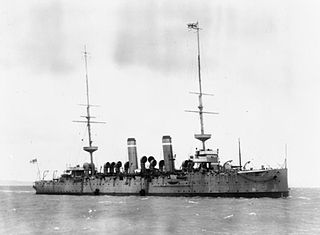
HMS Australia was one of seven Orlando-class armoured cruisers built for the Royal Navy in the mid-1880s. She was assigned to the Mediterranean Fleet in 1889 and remained there until 1893 when she returned home. The ship was assigned to the Coast Guard Squadron for the next decade before she was placed in reserve in 1903. Australia was sold for scrap in 1905.

HMS Galatea was one of seven Orlando-class armoured cruisers built for the Royal Navy in the mid-1880s. She was sold for scrap on 5 April 1905.

The Drake class was a four-ship class of armoured cruisers built around 1900 for the Royal Navy.

The Eclipse-class cruisers were a class of nine second-class protected cruisers constructed for the Royal Navy in the mid-1890s.

The Highflyer-class cruisers were a group of three second-class protected cruisers built for the Royal Navy in the late 1890s.

HMS Endymion was a first-class protected cruiser of the Edgar class. She served in China during the Boxer Rebellion and later in the First World War, and was sold in 1920.

HMS Shannon was a Minotaur-class armoured cruiser built for the Royal Navy in the mid-1900s. Before the First World War, she served with the Home Fleet, generally as the flagship of a cruiser squadron. The ship remained with the Grand Fleet, as the Home Fleet was renamed when the war began, for the entire war, but only participated in a single battle, the Battle of Jutland in May 1916. Shannon spent most of the war unsuccessfully patrolling the North Sea for German warships and commerce raiders. She was paid off in 1919 and sold for scrap in 1922.

The Blake class was a pair of first-class protected cruisers, the first of their rank in the Royal Navy, designed in the late 1880s and built around 1890.

HMS Undaunted was one of seven Orlando-class armoured cruisers built for the Royal Navy in the mid-1880s.

HMS Immortalité was one of seven Orlando-class armoured cruisers built for the Royal Navy in the mid-1880s. She was sold for scrap on 11 January 1907.

HMS Aurora was one of seven Orlando-class armoured cruisers built for the Royal Navy in the mid-1880s. The ship spent a brief time in reserve before she was assigned to the Channel Squadron for two years in 1890. In 1893 Aurora became a coast guard ship in Ireland for two years before she was placed in reserve again. The ship recommissioned in 1899 for service on the China Station and some of her crew participated in the Battle of Tientsin in 1900 during the Boxer Rebellion. Aurora returned home two years later and was again reduced to reserve. She was taken out of service in 1905 and sold for scrap on 2 October 1907.

HMS Adventure was the name ship of her class of two scout cruisers built for the Royal Navy during the first decade of the 20th century. For two years after being completed in 1905, the ship was in reserve. She was commissioned in mid-1907 as a flotilla leader in the Home Fleet. When the First World War began in August 1914, she was assigned to patrol the English Channel. In mid-1915 Adventure was transferred to Irish waters to serve as the flagship there. In early 1918, the ship escorted convoys to Gibraltar before being transferred to the Mediterranean at the end of the war. She returned home in mid-1919 and was paid off. Adventure was sold for scrap in early 1920.
HMS Hart was one of three Handy-class destroyers built for the Royal Navy in the 1890s. Completed in 1895 she spent most of her career on the China Station and was sold in 1912.

Admiral Kornilov was a protected cruiser of the Russian Imperial Navy. She was presumably named for Admiral Vladimir Alexeyevich Kornilov.

The Challenger-class cruisers were a pair of second-class protected cruisers built for the Royal Navy in the first decade of the 20th century. One ship, HMS Encounter, was later transferred to the Royal Australian Navy.

HMS Venus was an Eclipse-class protected cruiser built for the Royal Navy in the mid-1890s.

HMS Isis was an Eclipse-class protected cruiser built for the Royal Navy in the mid-1890s.

HMS Dido was an Eclipse-class protected cruiser built for the Royal Navy in the mid-1890s.

HMS Eclipse was an Eclipse-class protected cruiser built for the Royal Navy in the mid-1890s.

HMS Serpent, was an Archer-class torpedo cruiser of the Royal Navy. Serpent was built at Devonport Dockyard, entering service in 1888. She was lost when she ran aground off Cape Vilan in northwest Spain with the loss of 173 people out of 176 in her crew.



















